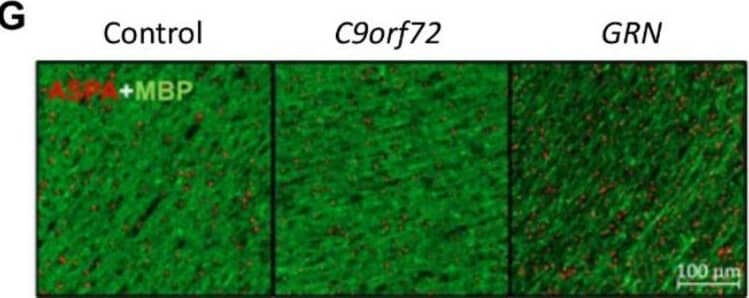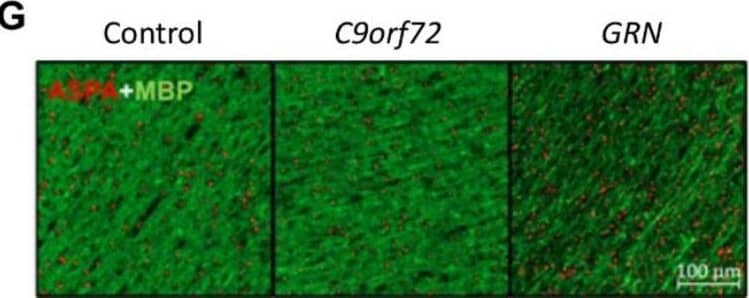Human/Mouse/Rat MBP Antibody Summary
Accession # P02686
Applications
Please Note: Optimal dilutions should be determined by each laboratory for each application. General Protocols are available in the Technical Information section on our website.
Scientific Data
 View Larger
View Larger
Detection of Human MBP by Western Blot. Western blot shows lysates of mouse brain (cerebellum) tissue and rat brain (cerebellum). PVDF membrane was probed with 0.1 µg/mL of Mouse Anti-Human/Mouse/Rat MBP Monoclonal Antibody (Catalog # MAB42282) followed by HRP-conjugated Anti-Mouse IgG Secondary Antibody (Catalog # HAF018). Specific bands were detected for MBP at approximately 15-22 kDa (as indicated). This experiment was conducted under reducing conditions and using Immunoblot Buffer Group 1.
 View Larger
View Larger
Detection of Mouse and Rat MBP by Western Blot. Western blot shows lysates of mouse brain (cerebellum) tissue and rat brain (cerebellum) tissue. PVDF membrane was probed with 0.1 µg/mL of Mouse Anti-Human/Mouse/Rat MBP Monoclonal Antibody (Catalog # MAB42282) followed by HRP-conjugated Anti-Mouse IgG Secondary Antibody (Catalog # HAF018). Specific bands were detected for MBP at approximately 15-22 kDa (as indicated). This experiment was conducted under reducing conditions and using Immunoblot Buffer Group 1.
 View Larger
View Larger
MBP in Rat Cortical Stem Cells. MBP was detected in immersion fixed rat cortical stem cells differentiated for 7 days to oligodendrocytes using Mouse Anti-Human/Mouse/Rat MBP Monoclonal Antibody (Catalog # MAB42282) at 10 µg/mL for 3 hours at room temperature. Cells were stained using the NorthernLights™ 557-conjugated Anti-Mouse IgG Secondary Antibody (red; Catalog # NL007) and counterstained with DAPI (blue). Specific staining was localized to cell surfaces, cytoplasm, and nuclei. View our protocol for Fluorescent ICC Staining of Stem Cells on Coverslips.
 View Larger
View Larger
MBP in Human Brain. MBP was detected in immersion fixed paraffin-embedded sections of human brain (cortex) using Mouse Anti-Human/Mouse/Rat MBP Monoclonal Antibody (Catalog # MAB42282) at 1.7 µg/mL for 1 hour at room temperature followed by incubation with the Anti-Mouse IgG VisUCyte™ HRP Polymer Antibody (Catalog # VC001). Before incubation with the primary antibody, tissue was subjected to heat-induced epitope retrieval using Antigen Retrieval Reagent-Basic (Catalog # CTS013). Tissue was stained using DAB (brown) and counterstained with hematoxylin (blue). Specific staining was localized to neuronal processes. View our protocol for IHC Staining with VisUCyte HRP Polymer Detection Reagents.
 View Larger
View Larger
MBP in Mouse Brain. MBP was detected in perfusion fixed frozen sections of mouse brain using Mouse Anti-Human/Mouse/Rat MBP Monoclonal Antibody (Catalog # MAB42282) at 0.1 µg/mL overnight at 4 °C. Tissue was stained using the NorthernLights™ 557-conjugated Anti-Mouse IgG Secondary Antibody (red; Catalog # NL007) and counterstained with DAPI (blue). Specific staining was localized to myelinated fibers. View our protocol for Fluorescent IHC Staining of Frozen Tissue Sections.
 View Larger
View Larger
MBP in Rat Brain. MBP was detected in perfusion fixed frozen sections of rat brain using Mouse Anti-Human/Mouse/Rat MBP Monoclonal Antibody (Catalog # MAB42282) at 0.1 µg/mL overnight at 4 °C. Tissue was stained using the NorthernLights™ 557-conjugated Anti-Mouse IgG Secondary Antibody (red; Catalog # NL007) and counterstained with DAPI (blue). Specific staining was localized to myelinated fibers. View our protocol for Fluorescent IHC Staining of Frozen Tissue Sections.
 View Larger
View Larger
Detection of Human MBP by Immunohistochemistry Pronounced myelin loss in FTD-GRN. (A, C) Representative western blots and (B, D) densitometric quantification of PLP, CNP, MBP, beta III-tubulin ( beta III-T) and neurofilament light chain (NF-L) in (A, B) superior frontal white matter, and (C, D) superior parietal white matter from control (n = 11), FTD-C9orf72 (n = 11), and FTD-GRN (n = 6) cases. Protein levels were normalised to beta -actin or GAPDH as a loading control, and are expressed relative to the mean of the control group. (E) Representative images and (F) myelination scores from LFB staining of superior frontal gyrus white matter from control (n = 5), FTD-C9orf72 (n = 4), and FTD-GRN (n = 3) cases from which tissue fixed for < 2 weeks was available. (G) Representative ASPA (red) and MBP (green) staining in superior frontal gyrus white matter, and (H) ASPA-positive cell density. Groups were compared by one-way ANOVA with Tukey’s post-test (B,D,H) or Kruskall-Wallis test with Dunn’s post-test (F): *p < 0.05; **p < 0.01; ***p < 0.001 Image collected and cropped by CiteAb from the following open publication (https://pubmed.ncbi.nlm.nih.gov/36967384), licensed under a CC-BY license. Not internally tested by R&D Systems.
 View Larger
View Larger
Detection of Human MBP by Immunohistochemistry Pronounced myelin loss in FTD-GRN. (A, C) Representative western blots and (B, D) densitometric quantification of PLP, CNP, MBP, beta III-tubulin ( beta III-T) and neurofilament light chain (NF-L) in (A, B) superior frontal white matter, and (C, D) superior parietal white matter from control (n = 11), FTD-C9orf72 (n = 11), and FTD-GRN (n = 6) cases. Protein levels were normalised to beta -actin or GAPDH as a loading control, and are expressed relative to the mean of the control group. (E) Representative images and (F) myelination scores from LFB staining of superior frontal gyrus white matter from control (n = 5), FTD-C9orf72 (n = 4), and FTD-GRN (n = 3) cases from which tissue fixed for < 2 weeks was available. (G) Representative ASPA (red) and MBP (green) staining in superior frontal gyrus white matter, and (H) ASPA-positive cell density. Groups were compared by one-way ANOVA with Tukey’s post-test (B,D,H) or Kruskall-Wallis test with Dunn’s post-test (F): *p < 0.05; **p < 0.01; ***p < 0.001 Image collected and cropped by CiteAb from the following open publication (https://pubmed.ncbi.nlm.nih.gov/36967384), licensed under a CC-BY license. Not internally tested by R&D Systems.
 View Larger
View Larger
Detection of MBP by Western Blot GCN2 deficiency impacts the length of myelinated segments and myelin levels. Sections (30 μm) of the brain derived from two-month-old male WT (n = 3) and genetically deficient GCN2 (GCN2−/−, n = 3) mice were obtained and processed for immunofluorescence to visualize myelin segments. (A) Representative images showing the myelin basic protein (MBP) (red) staining used as a myelin marker, the nuclei DAPI (blue), and the composed image (merge). An augmented section (white box) of the images are shown at the right (Zoom). Arrows on the zoom image show the type of MBP-positive objects quantified. (B) Images obtained in A were quantified using the Image J software (1.53t version). The plot shows the number and length of myelin segments (upper panel) and the average length (lower panel) of myelin segments found in WT and GCN2−/− mice. (C) Protein extracts were prepared from brains derived from two-month-old WT (n = 4) and GCN2−/− (n = 4) mice. MBP levels were analyzed by Western blot using alpha -Tubulin as a loading control (left). Each lane represents an individual (30 μg/lane). Densitometry analysis of the blot was performed by ImageJ to quantify the intensities of the two MBP bands and then normalized to alpha -Tubulin (right) levels. Scale bar: 100 μm. **** p < 0.00001, * p < 0.05. t-test analysis. Error bars represent the mean ± SEM. The whole Western blot membrane is shown in Supplementary Figure S1. The MBP quantification strategy is described in the “Materials and Methods” section. Image collected and cropped by CiteAb from the following open publication (https://pubmed.ncbi.nlm.nih.gov/40004088), licensed under a CC-BY license. Not internally tested by R&D Systems.
Reconstitution Calculator
Preparation and Storage
- 12 months from date of receipt, -20 to -70 °C as supplied.
- 1 month, 2 to 8 °C under sterile conditions after reconstitution.
- 6 months, -20 to -70 °C under sterile conditions after reconstitution.
Background: MBP
Myelin Basic Protein (MBP) is the most abundant protein component of the myelin membrane in the central nervous system. MBP has a role in both the formation and stabilization of this compact multilayer arrangement of bilayers. In vitro, MBP is suitable as a substrate for numerous protein kinases, including the ERK and p38 MAP kinases that phosphorylate MBP at T98.
Product Datasheets
Citations for Human/Mouse/Rat MBP Antibody
R&D Systems personnel manually curate a database that contains references using R&D Systems products. The data collected includes not only links to publications in PubMed, but also provides information about sample types, species, and experimental conditions.
11
Citations: Showing 1 - 10
Filter your results:
Filter by:
-
The major TMEM106B dementia risk allele affects TMEM106B protein levels, fibril formation, and myelin lipid homeostasis in the ageing human hippocampus
Authors: Lee JY, Harney DJ, Teo JD et al.
Mol Neurodegener
-
Injury-induced perivascular niche supports alternative differentiation of adult rodent CNS progenitor cells
Authors: Justyna Ulanska-Poutanen, Jakub Mieczkowski, Chao Zhao, Katarzyna Konarzewska, Beata Kaza, Hartmut BF Pohl et al.
eLife
-
A novel 3D bilayer hydrogel tri-culture system for studying functional motor units
Authors: Yu-Lung Lin, Jennifer Nhieu, Thomas Lerdall, Liming Milbauer, Chin-Wen Wei, Dong Jun Lee et al.
Cell Biosci
-
Vitamin C regulates Schwann cell myelination by promoting DNA demethylation of pro‐myelinating genes
Authors: Tyler C. Huff, David W. Sant, Vladimir Camarena, Derek Van Booven, Nadja S. Andrade, Sushmita Mustafi et al.
Journal of Neurochemistry
-
The major TMEM106B dementia risk allele affects TMEM106B protein levels, fibril formation, and myelin lipid homeostasis in the ageing human hippocampus
Authors: Lee JY, Harney DJ, Teo JD et al.
Mol Neurodegener
-
Human neural cell type-specific�extracellular vesicle proteome defines disease-related molecules associated with activated astrocytes in Alzheimer's disease brain
Authors: You Y, Muraoka S, Jedrychowski MP et al.
Journal of Extracellular Vesicles
-
Microglial lysosome dysfunction contributes to white matter pathology and TDP-43 proteinopathy in GRN-associated FTD
Authors: Y Wu, W Shao, TW Todd, J Tong, M Yue, S Koga, M Castanedes, AL Librero, CW Lee, IR Mackenzie, DW Dickson, YJ Zhang, L Petrucelli, M Prudencio
Cell Reports, 2021-08-24;36(8):109581.
Species: Mouse
Sample Types: Whole Tissue
Applications: IHC -
Quercetin Attenuates Diabetic Peripheral Neuropathy by Correcting Mitochondrial Abnormality via Activation of AMPK/PGC-1&alpha Pathway in vivo and in vitro
Authors: Q Zhang, W Song, B Zhao, J Xie, Q Sun, X Shi, B Yan, G Tian, X Liang
Frontiers in Neuroscience, 2021-03-03;15(0):636172.
Species: Rat
Sample Types: Whole Tissue
Applications: IHC -
Early Reperfusion Following Ischemic Stroke Provides Beneficial Effects, Even After Lethal Ischemia with Mature Neural Cell Death
Authors: Y Tanaka, N Nakagomi, N Doe, A Nakano-Doi, T Sawano, T Takagi, T Matsuyama, S Yoshimura, T Nakagomi
Cells, 2020-06-01;9(6):.
Species: Transgenic Mouse
Sample Types: Whole Cells
Applications: IHC -
5-HT1a activation in PO/AH area induces therapeutic hypothermia in a rat model of intracerebral hemorrhage
Authors: T Liang, Q Chen, Q Li, R Li, J Tang, R Hu, J Zhong, H Ge, X Liu, F Hua
Oncotarget, 2017-08-16;8(43):73613-73626.
Species: Rat
Sample Types: Whole Tissue
Applications: IHC -
Human neural cell type-specific�extracellular vesicle proteome defines disease-related molecules associated with activated astrocytes in Alzheimer's disease brain
Authors: You Y, Muraoka S, Jedrychowski MP et al.
Journal of Extracellular Vesicles
FAQs
No product specific FAQs exist for this product, however you may
View all Antibody FAQsReviews for Human/Mouse/Rat MBP Antibody
Average Rating: 5 (Based on 5 Reviews)
Have you used Human/Mouse/Rat MBP Antibody?
Submit a review and receive an Amazon gift card.
$25/€18/£15/$25CAN/¥75 Yuan/¥2500 Yen for a review with an image
$10/€7/£6/$10 CAD/¥70 Yuan/¥1110 Yen for a review without an image
Filter by:





